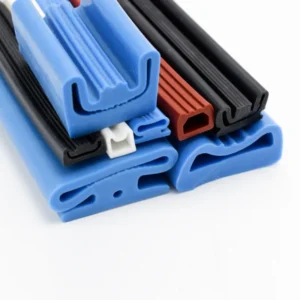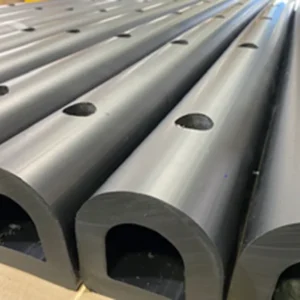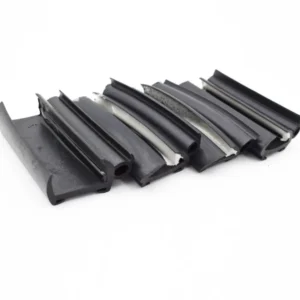Silicone Metal Reinforced Edge Trims
Silicone Metal Reinforced Edge Trims
Our silicone metal reinforced edge trims offer superior edge protection and sealing with the perfect combination of flexibility and durability. Designed with a metal core for enhanced grip and stability, these trims securely fit onto metal, glass, and plastic surfaces without adhesives. The silicone rubber exterior ensures excellent resistance to UV, extreme temperatures, and weathering, making them ideal for both indoor and outdoor applications.
Easy to install and low maintenance, these edge trims provide vibration dampening, impact resistance, and long-term performance across various industries. Whether you need protection, sealing, or insulation, our silicone metal reinforced edge trims deliver reliable, professional results for demanding environments.
Details About Silicone Metal Reinforced Edge Trims
Details About Silicone Metal Reinforced Edge Trims
Product Description
Our silicone metal reinforced edge trims are engineered to provide secure, flexible, and durable protection for sharp or exposed edges. These trims are designed with a metal reinforcement core for enhanced strength and stability, ensuring a tight grip on metal, glass, or plastic surfaces without adhesives. The silicone rubber exterior offers exceptional temperature resistance, UV stability, and weatherproofing, making these trims suitable for indoor and outdoor applications.
With easy installation and a long service life, these edge trims improve both safety and aesthetics, protecting surfaces from impact damage, vibration, and wear. Whether used for sealing, edge protection, or insulation, our silicone metal reinforced trims deliver consistent performance even under harsh environmental conditions.
Applications
Silicone metal reinforced edge trims are versatile and used across multiple industries, offering reliable sealing, protection, and insulation in various applications:
- Automotive and Transport
- Provides edge protection for doors, hatches, and windows
- Reduces vibration and noise in vehicles and trailers
- Construction and Architecture
- Secures edges on glass panels, doors, and partitions
- Enhances safety by covering sharp edges on structural components
- Marine and Offshore
- Protects hatches, windows, and enclosures from impact and corrosion
- Maintains durability under harsh marine conditions
- Industrial and Machinery
- Prevents damage to equipment edges and protects operators from sharp surfaces
- Acts as a seal to block dust, water, and contaminants in industrial settings
These trims are ideal for new installations or replacement projects, offering a simple and tool-free installation process to save time and reduce maintenance.
Common Silicone Metal Reinforced Edge Trims Materials
Selecting the right material ensures optimal performance, durability, and environmental resistance for your edge trim applications:
- Silicone Rubber
- Advantages: Excellent temperature resistance, flexibility, and UV stability. Ideal for applications exposed to heat and weather.
- Disadvantages: Higher cost compared to other rubbers.
- EPDM Rubber
- Advantages: Outstanding resistance to ozone, UV, and extreme weather. Suitable for outdoor use.
- Disadvantages: Less heat-resistant than silicone.
- Neoprene Rubber
- Advantages: Good resistance to oils, chemicals, and abrasion. Performs well in marine environments.
- Disadvantages: Less flexible than silicone at lower temperatures.
- Metal Reinforcement Core
- Advantages: Provides structural strength, ensuring a firm grip on surfaces.
- Disadvantages: May add weight to the profile, depending on application needs.
Choosing the appropriate material combination ensures durability and performance in even the most demanding environments, minimizing maintenance and extending product life.
Discuss the details of
your seal solution
Submit Your Inquiry to Primesealsolution,
All the Inquiries Will Be Replied Within 12 Hours.
More Rubber Seals Support Your Project
More Rubber Seals Support Your Project
FAQ For Rubber Seals
FAQ For Rubber Seals
How to Choose the Right Material?
Customers often ask how to select the appropriate material based on their working environment (e.g., high temperature, low temperature, chemical corrosion). Common materials include EPDM, silicone, nitrile rubber (NBR), and fluororubber (FKM), each offering specific resistance properties for different applications
What Temperature Range Can the Seal Handle?
Customers often ask how to select the appropriate material based on their working environment (e.g., high temperature, low temperature, chemical corrosion). Common materials include EPDM, silicone, nitrile rubber (NBR), and fluororubber (FKM), each offering specific resistance properties for different applications
What Are the Key Points to Ensure Proper Installation?
Proper installation is crucial for performance, and customers want to know how to keep the surface clean, avoid over-stretching, and whether to use lubricants for easier installation
What Should I Do if the Seal Ages or Fails?
Over time, seals may crack or deform. Customers often inquire about how to identify these issues early and use rubber rejuvenators to prolong their lifespan or properly replace failed seals
What Should I Do if the Seal Ages or Fails?
Over time, seals may crack or deform. Customers often inquire about how to identify these issues early and use rubber rejuvenators to prolong their lifespan or properly replace failed seals
Are Rubber Seals Environmentally Friendly?
Clients in eco-focused industries may ask about the material’s recyclability and environmental compliance, especially for projects aligned with green building certifications
How Can I Extend the Seal’s Service Life?
Customers are interested in maintenance tips such as choosing suitable materials, regular cleaning, avoiding overloading, and ensuring proper use to maximize durability






